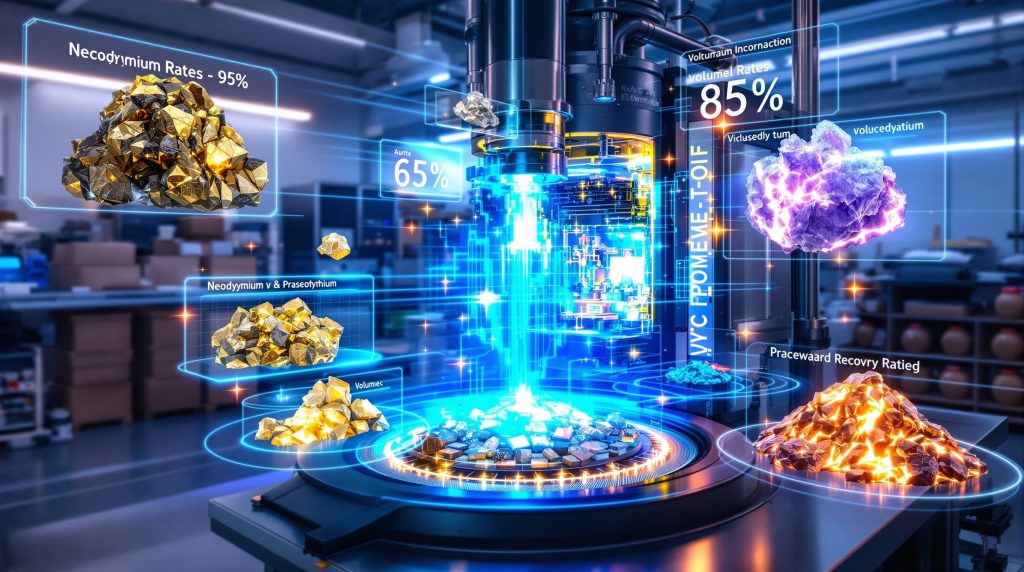Revolutionizing Critical Minerals Recovery: Microwave Technology for Rare Earth Elements Extraction
Electromagnetic innovation is transforming how industries recover valuable rare earth elements (REEs) from various materials, offering unprecedented efficiency gains while reducing environmental impact. This groundbreaking approach leverages targeted energy delivery to revolutionize extraction processes that have remained largely unchanged for decades.
How Microwave Technology Transforms Rare Earth Elements Extraction
Microwave technology represents a fundamental shift in REE extraction methodology. Unlike conventional processes that rely on bulk heating through conduction and convection, microwave extraction uses electromagnetic energy to target specific materials based on their dielectric properties. This selective approach enables rapid, volumetric heating that dramatically improves extraction efficiency.
The technology works by directing microwave energy into REE-bearing materials, creating rapid internal heating that enhances chemical reactions and alters mineral structures. This process facilitates the liberation of rare earth elements that would otherwise remain trapped or require extensive chemical processing to extract.
The Science Behind Microwave-Assisted REE Extraction
The effectiveness of microwave technology stems from several key scientific principles:
Selective Heating Mechanism: Materials respond differently to microwave energy based on their dielectric properties. This selectivity allows precise targeting of REE-containing components while minimizing energy waste on surrounding materials.
Volumetric Energy Transfer: Traditional heating methods work from the outside in, creating temperature gradients that reduce efficiency. Microwave energy generates heat throughout the entire material simultaneously, ensuring uniform processing.
Enhanced Reaction Kinetics: Laboratory studies show microwave energy accelerates chemical reactions by lowering activation energy barriers, enabling reactions to occur more rapidly and completely.
Structural Modification: The rapid heating creates microscopic fractures and alters mineral morphology at the molecular level, improving access to embedded REEs that would otherwise remain inaccessible.
Recent laboratory testing demonstrates remarkable efficiency gains, with recovery rates exceeding 95% for neodymium and 80% for praseodymium—with potential to reach over 90% when oxidants are added to the process.
Why Innovation in REE Extraction is Critical for Global Supply Chains
The global transition to clean energy technologies has dramatically increased demand for critical minerals in energy transition, which serve as essential components in everything from wind turbines and electric vehicles to advanced electronics and defense systems.
Traditional extraction methods face significant limitations in meeting this growing demand while addressing mounting environmental concerns. The industry has reached a critical juncture where innovation isn't merely beneficial—it's essential for sustainable supply chain development.
Current Challenges in Conventional REE Processing
Conventional REE extraction faces multiple challenges that limit its sustainability and scalability:
Resource-Intensive Operations: Traditional methods require extensive chemical reagents, high temperatures maintained over long periods, and prolonged processing times that drive up costs and energy consumption.
Environmental Concerns: Conventional extraction typically generates substantial waste streams and chemical pollution, creating long-term environmental liabilities and increasing regulatory scrutiny.
Supply Chain Vulnerabilities: Geographic concentration of REE processing capabilities—primarily in China—creates strategic risks for technology manufacturers worldwide. This concentration has prompted governments to seek alternative domestic processing capabilities.
Recovery Inefficiencies: Standard techniques often achieve suboptimal recovery rates, particularly from low-grade sources and waste materials, leaving valuable resources unrecovered.
Industry experts note that diversifying REE supply chains represents a medium-term commercial opportunity that aligns with broader economic security initiatives in many countries.
What Performance Advantages Does Microwave Technology Offer?
Microwave-assisted extraction delivers measurable improvements across multiple performance metrics compared to conventional REE processing methods. These advantages are particularly evident when processing metallurgical waste and secondary sources.
Quantifiable Performance Improvements
Laboratory testing has demonstrated significant performance advantages across key metrics:
| Performance Metric | Conventional Methods | Microwave Technology | Improvement |
|---|---|---|---|
| Neodymium Recovery | 70-85% | >95% | +10-25% |
| Praseodymium Recovery | 60-75% | >80% (>90% with oxidants) | +15-30% |
| Processing Time | 8-24 hours | 1-4 hours | 75-95% reduction |
| Energy Consumption | High (bulk heating) | Low (selective heating) | Up to 85% reduction |
| Chemical Reagent Use | High volumes | Significantly reduced | 40-60% reduction |
| PGM Recovery (Pt, Pd, Rh) | Variable/moderate | Excellent | Substantial improvement |
These improvements stem from the fundamental differences in how microwave energy interacts with materials compared to conventional heating. The selective nature of microwave heating targets specific minerals, dramatically reducing wasted energy while accelerating the extraction process.
Beyond REEs, the technology has demonstrated excellent recovery rates for platinum group metals (PGMs) including platinum, palladium, and rhodium—high-value materials crucial for catalytic converters and other advanced technologies.
How Microwave Technology Supports Sustainable Resource Recovery
The environmental advantages of microwave-assisted REE extraction align with growing global emphasis on mining sustainability transformation and circular economy principles for critical minerals.
Environmental and Sustainability Benefits
Microwave technology offers multiple sustainability advantages:
Reduced Carbon Footprint: The lower energy requirements translate to decreased greenhouse gas emissions across the extraction process. The selective heating mechanism eliminates the need to heat entire solution volumes or material batches.
Minimized Chemical Usage: The process requires significantly less reliance on harsh acids and solvents, reducing environmental contamination risks and workplace hazards while decreasing input costs.
Waste Stream Valorization: The technology enables economic recovery of valuable elements from metallurgical waste and industrial byproducts that would otherwise require disposal, creating value from materials previously considered waste.
Water Conservation: The process requires substantially less water than conventional hydrometallurgical methods, an important consideration as water scarcity affects more mining regions globally.
Smaller Physical Footprint: The compact equipment design allows for more flexible facility placement and reduced land disturbance compared to conventional processing plants.
Industry professionals highlight that microwave heating provides an efficient, rapid, and sustainable heating transmission alternative to traditional acid leaching processes that have dominated the industry for decades.
What Materials Can Be Processed Using Microwave Technology?
Microwave-assisted extraction has demonstrated effectiveness across a diverse range of REE-bearing materials, including both primary ores and secondary sources. This versatility makes it particularly valuable for addressing the varied waste streams that contain critical minerals.
Proven Source Materials for Microwave Processing
The technology has shown promising results with multiple material types:
Metallurgical Waste: Slags, residues, and byproducts from metal refining operations often contain significant concentrations of REEs and other valuable metals that conventional processes fail to recover economically.
End-of-Life Products: Electronic waste, spent catalysts, and decommissioned renewable energy components represent growing sources of REEs that can be processed using microwave technology.
Industrial Byproducts: Phosphogypsum from fertilizer production, coal fly ash, and red mud from aluminum processing all contain REEs that can be extracted more efficiently using microwave-assisted methods.
Low-Grade Ores: Deposits previously considered uneconomical using conventional extraction methods may become viable resources with the improved recovery rates and reduced processing costs of microwave technology.
PGM-Containing Materials: Catalytic converters and electronic scrap containing platinum group metals respond particularly well to microwave processing, offering improved recovery of these high-value elements.
Companies like Livium have identified strong connections to REE end-of-life supply chains through clean energy generation and e-mobility clients, positioning them to secure waste streams either directly from customers or for processing through technology partnerships.
What Technical Innovations Make Microwave REE Extraction Possible?
The development of specialized microwave reactors and processing parameters has been crucial to unlocking the potential of this technology for rare earth extraction. Recent advances in materials science and electromagnetic engineering have overcome many previous limitations.
Key Technical Developments
Several technical innovations underpin the effectiveness of microwave REE extraction:
Customized Reactor Designs: Purpose-built chambers with precise electromagnetic field control ensure optimal energy distribution throughout the target material. These specialized designs overcome the field uniformity challenges that plagued earlier microwave applications.
Advanced Process Control Systems: Real-time monitoring and adjustment of microwave power, duration, and frequency allow for process optimization based on specific material characteristics and desired outcomes.
Hybrid Heating Approaches: Some systems combine microwave energy with conventional heating for optimized processing, leveraging the advantages of both methods at different stages of the extraction process.
Specialized Additives: Researchers have developed microwave-responsive materials that enhance heating efficiency and selectivity when added to the target material, further improving processing effectiveness.
Scaled Reactor Configurations: The technology has progressed from laboratory to prototype scale, with commercial-scale systems now in development. The University of Melbourne is developing prototype-scale microwave reactor technology with industry partners.
These technical advances have transformed microwave-assisted extraction from a laboratory curiosity to a commercially viable technology with significant advantages over conventional methods.
How Are Commercial Partnerships Advancing Microwave REE Technology?
Strategic collaborations between industry, research institutions, and government funding bodies are accelerating the commercialization of microwave-assisted REE extraction technology. These partnerships bridge the gap between laboratory research and industrial application.
Notable Industry-Research Collaborations
Several key partnership models are driving technology advancement:
University-Industry Partnerships: Research institutions are working with mining and recycling companies to scale laboratory successes to commercial applications. For example, Livium has partnered with the University of Melbourne with an initial investment of $65,000, potentially increasing to $250,000 upon securing additional funding.
Government Funding Initiatives: Programs like Australia's Economic Accelerator Ignite are supporting prototype development, recognizing the strategic importance of domestic rare earth processing capabilities.
Intellectual Property Agreements: Long-term licensing arrangements are securing commercial rights to emerging technologies. Livium is working toward a binding intellectual property licensing agreement that will provide exclusive worldwide rights to commercialize the University of Melbourne's technology for 20 years.
Supply Chain Integration: Partnerships are connecting REE waste generators with processing technology providers, creating closed-loop systems that improve resource efficiency.
Staged Investment Approaches: Phased funding tied to achievement of technical and commercial milestones helps manage risk while providing necessary capital for continued development.
These collaborative approaches allow participants to share risks and resources while accelerating technology development and commercialization.
What Are the Economic Implications of Microwave REE Extraction?
Microwave technology offers compelling economic advantages that could reshape the rare earth elements market and supply chain dynamics. These benefits extend beyond simple cost reduction to enabling entirely new business models.
Economic Benefits and Market Impacts
The technology presents several economic advantages:
Reduced Operating Costs: Lower energy, chemical, and labor requirements decrease overall processing expenses, improving profit margins and making previously uneconomical resources viable.
Higher Value Recovery: Improved extraction rates for high-value elements enhance project economics, particularly for materials containing precious metals alongside REEs.
Supply Chain Diversification: The technology enables economic processing in regions previously considered unviable, potentially reducing dependency on current production centers.
Processing Flexibility: The ability to handle diverse feedstocks reduces dependency on specific ore types or suppliers, improving operational resilience.
Smaller Capital Requirements: The compact equipment footprint may reduce initial investment compared to conventional facilities, lowering barriers to entry for new market participants.
Industry perspective indicates REEs represent a medium-term commercial opportunity driven by global shifts toward more diversified supply chains. Companies implementing this technology can expand their commercial offerings and strengthen their leadership positions in resource recovery and process innovation.
What Technical Challenges Remain for Widespread Adoption?
Despite promising results, several technical hurdles must be addressed to enable broad commercial implementation of microwave REE extraction technology. Resolving these challenges requires continued research and development investment.
Ongoing Technical Development Areas
Key challenges that require further work include:
Scale-Up Engineering: Translating laboratory success to continuous commercial-scale operations presents significant engineering challenges, particularly in maintaining process consistency at larger volumes.
Process Optimization: Refining operating parameters for diverse feedstock materials requires extensive testing and characterization to maximize efficiency across variable input materials.
Materials Science Challenges: Developing reactor components that withstand intense electromagnetic fields and chemical environments over extended operational periods remains challenging.
Energy Efficiency Improvements: Further reducing power consumption through advanced reactor designs and process optimization will improve economic performance and sustainability metrics.
Integration with Downstream Processing: Ensuring microwave-extracted REEs meet specifications for subsequent separation and refining steps is essential for seamless integration into existing supply chains.
Companies like Livium continue to actively assess other REE extraction technologies in Australia and overseas, indicating that microwave technology for rare earth elements extraction is one of several approaches being explored to address the growing demand for rare earth elements.
How Might Microwave Technology Reshape the Global REE Supply Chain?
The widespread adoption of microwave-assisted extraction could significantly impact global rare earth element markets and supply chain resilience. These changes could alter current market dynamics and create new opportunities.
Potential Market and Supply Chain Impacts
Several transformative effects may emerge:
Geographical Diversification: By enabling economic processing in more locations worldwide, microwave technology could reduce the current geographic concentration of REE processing capabilities.
Secondary Source Utilization: Transforming waste streams into valuable REE sources could significantly expand the resource base, reducing pressure on primary mining operations.
Supply Security Enhancement: Reducing dependency on geographically concentrated traditional processing hubs would improve supply security for critical technology manufacturers.
Market Entry Barriers: Lowering capital and operational requirements for new market participants could increase competition and innovation in the REE processing sector.
Price Stability Contributions: Potentially moderating price volatility through diversified supply sources would benefit both producers and consumers of rare earth elements.
Industry movement toward more diversified supply chains creates opportunities for new extraction technologies like microwave-assisted processing, with existing client connections to clean energy generation and e-mobility sectors demonstrating potential integration points.
What Are the Next Steps for Microwave REE Extraction Technology?
The pathway from current prototype development to widespread commercial implementation involves several critical phases and milestones. Successful navigation of this process will determine how quickly the technology can impact global REE markets.
Technology Commercialization Roadmap
Key steps in the commercialization process include:
Prototype Validation: Demonstrating consistent performance at pilot scale with diverse feedstocks represents a critical milestone. The University of Melbourne is working toward delivering initial REE product test results from its prototype system.
Process Optimization: Refining operating parameters to maximize efficiency and recovery rates will improve economic performance and broaden applicable material types.
Regulatory Approval: Securing necessary permits and certifications for commercial operations ensures compliance with environmental and safety requirements.
Commercial Demonstration: Establishing first full-scale commercial facilities to validate economic models will provide the proof of concept needed for broader adoption.
Market Education: Building awareness and acceptance among potential adopters and investors remains essential for technology diffusion.
Supply Chain Integration: Developing partnerships with upstream suppliers and downstream processors will create complete value chains for recovered REEs.
The technology is progressing from initial research phases to prototype development, with binding intellectual property licensing agreements in development to secure commercialization rights. As mining industry innovation continues to advance, implementing advanced extraction technologies like microwave processing will be crucial for maintaining competitive advantage.
FAQ: Microwave Technology for REE Extraction
What makes microwave extraction different from conventional REE processing?
Microwave extraction selectively heats REE-bearing materials based on their dielectric properties, creating more efficient energy transfer, faster processing times, and reduced chemical requirements. Conventional methods rely primarily on bulk heating through conduction and convection, which wastes energy and requires longer processing times.
Can microwave technology process all types of rare earth deposits?
While microwave technology has demonstrated effectiveness across many REE-bearing materials, its efficiency varies depending on the specific mineralogy and composition. It shows particular promise for processing metallurgical wastes, industrial byproducts, and certain ore types that respond well to dielectric heating.
What recovery rates can be achieved with microwave extraction?
Laboratory studies have demonstrated recovery rates exceeding 95% for neodymium and 80% for praseodymium (potentially exceeding 90% with oxidants), representing significant improvements over conventional methods. Recovery rates for other REEs vary based on their specific mineral associations and process parameters.
How does microwave extraction impact the environment compared to traditional methods?
Microwave extraction typically reduces environmental impact through lower energy consumption, decreased chemical usage, reduced waste generation, and smaller physical footprint. The process can also valorize waste streams that might otherwise require disposal, contributing to circular economy principles and effective waste management solutions.
What is the current commercial status of microwave REE extraction technology?
The technology is transitioning from laboratory to commercial scale, with several companies and research institutions developing prototype systems. Commercial implementation requires further scale-up engineering, process optimization, and demonstration of economic viability at production scale.
Disclaimer: This article contains forward-looking statements regarding emerging technology. Actual performance of microwave extraction systems may vary based on specific materials, processing conditions, and system designs. Readers should conduct their own due diligence before making investment or implementation decisions based on this information.
Ready to Invest in the Next Major Mineral Discovery?
Discover significant ASX mineral discoveries the moment they're announced with Discovery Alert's proprietary Discovery IQ model, which transforms complex mineral data into actionable insights that give you an immediate market advantage. Explore why historic discoveries can generate substantial returns by visiting Discovery Alert's dedicated discoveries page and begin your 30-day free trial today.




